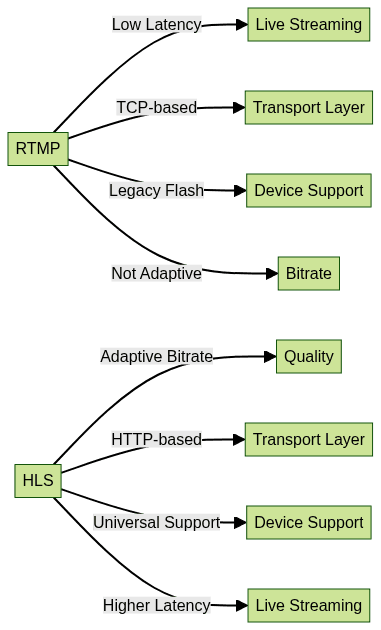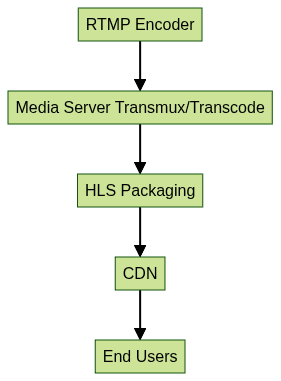Introduction to RTMP to HLS
Live streaming
has become an essential part of digital communication, powering everything from esports tournaments to global conferences. At the heart oflive streaming
are protocols like Real-Time Messaging Protocol (RTMP) and HTTP Live Streaming (HLS). Converting RTMP to HLS is a pivotal step for modern streaming, ensuring wider compatibility and scalability. As Flash has faded and audiences expect seamless video on every device, understanding this conversion workflow is key for developers and streaming engineers. This guide delves into the process, tools, and best practices for RTMP to HLS conversion, integrating high-value keywords for SEO and 2025 relevance.Understanding Streaming Protocols: RTMP and HLS
What is RTMP?
RTMP, or Real-Time Messaging Protocol, was originally developed by Macromedia (later acquired by Adobe) for delivering audio, video, and data over the internet. RTMP gained widespread adoption thanks to its low-latency capabilities and Flash Player integration, making it the backbone of live streaming during the 2000s and early 2010s. While Flash support has ended, RTMP remains widely used as an ingest protocol due to its stability and real-time features.
What is HLS?
HLS, or HTTP Live Streaming, is Apple’s adaptive streaming protocol introduced in 2009. Unlike RTMP, HLS breaks video into small HTTP-based segments, enabling smooth playback on a wide variety of devices, including iOS, Android, desktops, and smart TVs. Its support for adaptive bitrate streaming ensures optimal video quality based on viewer bandwidth, making it the industry standard for last-mile delivery in 2025. For developers building real-time communication features, leveraging a
Video Calling API
alongside HLS can further enhance interactive streaming experiences.RTMP vs HLS: Key Differences

| Feature | RTMP | HLS |
|---|---|---|
| Latency | Low | Higher |
| Device Support | Limited (Flash) | Universal (HTML5) |
| Adaptive Bitrate | No | Yes |
| Protocol | TCP | HTTP |
| CDN Friendly | No | Yes |
Why Convert RTMP to HLS?
The transition from RTMP to HLS is driven by several critical factors:
- Device and Browser Compatibility: With Flash deprecated, native RTMP playback is no longer feasible in browsers or on most devices. HLS, being HTTP-based, is universally supported by modern platforms, ensuring seamless delivery to desktops, mobiles, and smart TVs. If you're developing for mobile, exploring
webrtc android
can provide additional insights into real-time streaming on Android devices. - Scalability and CDN Support: HLS is designed for compatibility with Content Delivery Networks (CDNs), making it ideal for scaling live streams to massive audiences across the globe. RTMP streams, in contrast, struggle with efficient large-scale distribution.
- Adaptive Bitrate and Mobile-Friendliness: HLS enables adaptive bitrate streaming, which dynamically adjusts video quality based on the viewer’s connection. This is essential for delivering a smooth experience, especially for mobile users with variable networks.
- Compliance with Industry Standards: Major platforms and broadcasters have adopted HLS as the de facto standard for live video delivery, ensuring future-proof workflows and broader compatibility.
The RTMP to HLS Workflow Explained
High-Level Workflow Overview
The RTMP to HLS conversion pipeline involves several stages, from ingest to final delivery.

Key Components: Encoders, Media Servers, CDN
- Encoders (RTMP Encoder): Hardware or software tools that capture and compress live video, pushing the stream to a media server via RTMP.
- Media Servers: Software like NGINX-RTMP, Wowza, or Nimble Streamer that receive RTMP, transmux or transcode it, and repackage the output as HLS segments. For those building cross-platform apps, integrating
flutter webrtc
can enable seamless real-time video communication alongside your streaming infrastructure. - CDN (Content Delivery Network): Distributes HLS segments globally for low-latency, reliable streaming to end-users, regardless of location.
Transmuxing vs Transcoding
- Transmuxing: Converts the container format without altering the video/audio codecs. E.g., repackaging RTMP (FLV container) to HLS (MPEG-TS segments) when codecs are compatible. Fast and efficient, with minimal CPU usage.
- Transcoding: Re-encodes video/audio streams to different codecs or bitrates, enabling compatibility and adaptive streaming, but requires significant processing power. Necessary when input streams use unsupported codecs or when creating multiple renditions for adaptive bitrate.
Practical Implementation: Converting RTMP to HLS
Using FFmpeg for RTMP to HLS
FFmpeg is a powerful, open-source command-line tool for multimedia processing. It can ingest RTMP streams and output HLS segments with ease. If you're working with JavaScript, integrating a
javascript video and audio calling sdk
can help you add interactive features to your live streams.Example FFmpeg command:
1ffmpeg -i rtmp://localhost/live/stream \
2 -c:v libx264 -c:a aac -f hls \
3 -hls_time 4 -hls_list_size 10 -hls_flags delete_segments \
4 /var/www/html/hls/stream.m3u8
5-i: RTMP input URL-c:v libx264 -c:a aac: Video/audio codecs-f hls: Output format-hls_time: HLS segment duration (in seconds)-hls_list_size: Number of segments in the playlist-hls_flags delete_segments: Manage old segments for efficiency
This command takes an RTMP stream and creates HLS segments for HTTP delivery.
Using NGINX with RTMP Module
NGINX with the nginx-rtmp-module is a popular choice for developers seeking a lightweight, open-source RTMP to HLS solution. For those building mobile apps, leveraging a
react native video and audio calling sdk
can streamline the integration of real-time communication features into your streaming application.Sample NGINX configuration:
1rtmp {
2 server {
3 listen 1935;
4 chunk_size 4096;
5 application live {
6 live on;
7 hls on;
8 hls_path /var/www/html/hls;
9 hls_fragment 4;
10 hls_playlist_length 60;
11 }
12 }
13}
14http {
15 server {
16 listen 8080;
17 location /hls {
18 types {
19 application/vnd.apple.mpegurl m3u8;
20 video/mp2t ts;
21 }
22 root /var/www/html;
23 add_header Cache-Control no-cache;
24 }
25 }
26}
27- RTMP server listens for inbound streams
- HLS output is enabled and segments are saved to
/var/www/html/hls - HTTP server serves
.m3u8and.tsfiles via port 8080
Using Commercial Streaming Servers (Wowza, Nimble, etc.)
Commercial servers like Wowza Streaming Engine and Nimble Streamer offer robust, enterprise-ready RTMP to HLS workflows. They feature:
- Pros: Intuitive UIs, advanced analytics, integrated DRM, support for multiple input/output protocols, and professional support. If you want to quickly
embed video calling sdk
features into your live streaming platform, prebuilt solutions can significantly reduce development time. - Cons: Licensing costs, potential vendor lock-in, less flexibility for custom workflows.
For mission-critical broadcasting or large-scale deployments, these solutions offer reliability and comprehensive feature sets.
Troubleshooting Common Issues
- Latency: HLS introduces more latency than RTMP. Lower segment duration and playlist size to minimize delay, but test for stability.
- Sync Errors: Audio/video desynchronization can occur if input streams are unstable. Ensure encoder settings are consistent.
- Codec Compatibility: Ensure your RTMP input uses codecs supported by HLS (typically H.264 for video, AAC for audio) to avoid unnecessary transcoding.
Optimizing RTMP to HLS for Adaptive Bitrate Streaming
Adaptive Bitrate (ABR) streaming improves the viewer experience by offering multiple renditions of your stream at different bitrates and resolutions. For those looking to enhance their live streaming workflows, a
Video Calling API
can be integrated to support real-time interaction alongside adaptive streaming.Setting Up Multiple HLS Renditions
To create ABR streams, generate multiple HLS outputs (e.g., 1080p, 720p, 480p) using FFmpeg or your media server. Each rendition should use different encoding settings appropriate for the target bandwidth.
Bandwidth Considerations
Plan bitrate ladders based on your audience and device mix. Lower bitrates maximize accessibility for users on limited connections, while higher bitrates deliver quality for those with robust bandwidth.
Example FFmpeg Command for ABR
1ffmpeg -re -i rtmp://localhost/live/stream \
2 -map v:0 -map a:0 -c:v:0 libx264 -b:v:0 5000k -s:v:0 1920x1080 \
3 -map v:0 -map a:0 -c:v:1 libx264 -b:v:1 2500k -s:v:1 1280x720 \
4 -map v:0 -map a:0 -c:v:2 libx264 -b:v:2 1200k -s:v:2 854x480 \
5 -c:a aac -f hls -hls_time 4 -hls_list_size 6 -hls_flags independent_segments \
6 -var_stream_map "v:0,a:0 v:1,a:0 v:2,a:0" \
7 -master_pl_name master.m3u8 \
8 /var/www/html/hls/stream_%v.m3u8
9This single FFmpeg command generates three HLS renditions and a master playlist for ABR delivery.
Best Practices for RTMP to HLS Conversion
- Security: Use authentication and encryption (SSL/TLS) for both RTMP ingest and HLS delivery to protect your streams from unauthorized access.
- Scalability: Leverage CDNs to distribute HLS content efficiently. Set up origin shielding and edge caching for minimal latency.
- Reliability: Monitor stream health and server performance with tools like Prometheus, Grafana, or built-in analytics from commercial servers.
- CDN Integration: Use signed URLs and token authentication to prevent hotlinking and unauthorized redistribution of your HLS streams.
- Monitoring and Analytics: Collect metrics on viewership, performance, and errors to continually optimize your workflow and ensure a seamless user experience. If you're ready to enhance your streaming setup,
Try it for free
and explore the latest live streaming and video calling solutions.
Conclusion: The Future of RTMP to HLS
Converting RTMP to HLS is now an industry standard for robust, scalable, and device-friendly live streaming workflows in 2025. HLS’s universal compatibility, adaptive bitrate support, and CDN friendliness make it the protocol of choice for last-mile delivery. As streaming standards evolve, expect further improvements in latency, security, and efficiency, but the core RTMP to HLS pipeline will remain a cornerstone of professional broadcasting and video delivery.
Want to level-up your learning? Subscribe now
Subscribe to our newsletter for more tech based insights
FAQ